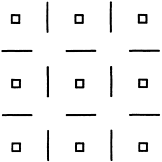163.
| [Cover] [Contents] [Index] |
Page 244
6.2.2 The line process
The ideas described in the previous section are mainly designed to achieve a smoothing operation. However, in practice, the patterns in an image are piecewise continuous. That is, discontinuities (i.e. edges between different patches) can usually be found within an image. In such cases, using a smoothing operation may smear these discontinuities, and result in an oversmoothed classification. An approach, though not a very satisfactory one, to solve this problem is first to implement a smoothing operation over the whole image, followed by edge detection to mark the location of discontinuities and, finally, re-interpolating smooth patches over the continuous subregions (Terzopoulos, 1984). Owing to the fact that the boundaries are likely to have been blurred in the first smoothing operation and may be hard to recover later, a more elegant approach is required.
A more flexible method, which can perform smooth interpolation and edge detection simultaneously, is called a line process (Geman and Geman, 1984). In Figure 6.7, the symbol  denotes the existing lattices on an image; the symbols—and | denote the possible edges (note that only horizontal and vertical edges are considered) occurring between each pair of neighbouring pixels. Once a discontinuity (edge) between two adjacent pixels is detected, the interaction (i.e. the intensity of the smoothing operation) between these two neighbouring pixels is reduced, and it is reasonable to define another potential function to respond to the presence of the edge. According to this logic, the prior energy term in Equation (6.14) can be modified to:
denotes the existing lattices on an image; the symbols—and | denote the possible edges (note that only horizontal and vertical edges are considered) occurring between each pair of neighbouring pixels. Once a discontinuity (edge) between two adjacent pixels is detected, the interaction (i.e. the intensity of the smoothing operation) between these two neighbouring pixels is reduced, and it is reasonable to define another potential function to respond to the presence of the edge. According to this logic, the prior energy term in Equation (6.14) can be modified to:
 |
(6.19) |
where, in general, Err′ {0, 1} which is defined as Err′=1 if wr=wr′, and Err′=0 otherwise. Err′ is an index for specifying whether an edge exists between pixel r and its neighbour r′ (i.e. Err′=1) or not (Err′=0). Equation
{0, 1} which is defined as Err′=1 if wr=wr′, and Err′=0 otherwise. Err′ is an index for specifying whether an edge exists between pixel r and its neighbour r′ (i.e. Err′=1) or not (Err′=0). Equation

Figure 6.7 Pixels  and the horizontal—and vertical | edges.
and the horizontal—and vertical | edges.
| [Cover] [Contents] [Index] |
EAN: 2147483647
Pages: 354